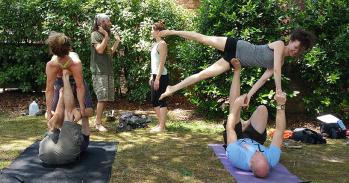
School uniform policies could be restricting young people from being active, particularly primary school-aged girls, new research suggests.
School uniform policies could be restricting young people from being active, particularly primary school-aged girls, new research suggests.
Social norms and expectations tend to influence what they feel they can do in these clothes. Unfortunately, when it comes to promoting physical health, that’s a problem
Esther van Sluijs
The University of Cambridge study used data about the physical activity participation of more than a million five-to-17-year-olds internationally. It found that in countries where a majority of schools require students to wear uniforms, fewer young people tend to meet the average of 60 minutes of physical activity per day recommended by the World Health Organisation (WHO).
Regardless of uniform policies, across most countries fewer girls than boys reach those recommended exercise levels. Among primary school students, however, the difference in activity between girls and boys was found to be wider in countries where most schools mandated uniforms. The same result was not found in secondary school-aged students.
The authors suggest that this could be explained by the fact that younger children get more incidental exercise throughout the school day than older students; for example, through running, climbing and various other forms of active play at break and lunchtimes. There is already evidence that girls feel less comfortable in participating in active play if they are wearing certain types of clothing, such as skirts or dresses.
Importantly, the results do not definitively prove that school uniforms limit children’s physical activity and the researchers stress that “causation cannot be inferred”. Previous, smaller studies however provide support for these findings, indicating that uniforms could pose a barrier. For the first time, the research examines large-scale statistical evidence to assess that claim.
The study was led by Dr Mairead Ryan, a researcher at the Faculty of Education and Medical Research Council (MRC) Epidemiology Unit, University of Cambridge.
“Schools often prefer to use uniforms for various reasons,” Dr Ryan said. “We are not trying to suggest a blanket ban on them, but to present new evidence to support decision-making. School communities could consider design, and whether specific characteristics of a uniform might either encourage or restrict any opportunities for physical activity across the day.”
The WHO recommends that young people get an average of 60 minutes of at least moderate-intensity physical activity per day during the week. The study confirms previous observations that most children and adolescents are not meeting this recommendation, especially girls. The difference in the percentage of boys and girls meeting physical activity guidelines across all countries was, on average, 7.6 percentage points.
Existing evidence suggests that uniforms could be a factor. Previous concerns have, for example, been raised about girls’ PE uniforms and school sports kits. A 2021 study in England found that the design of girls’ PE uniforms deterred students from participating in certain activities, while the hockey player Tess Howard proposed redesigning gendered sports uniforms for similar reasons, after analysing interview and survey data.
Children often get their exercise away from PE and sports lessons, however.
“Activities like walking or cycling to school, breaktime games, and after-school outdoor play can all help young people incorporate physical activity into their daily routines,” Ryan said. “That’s why we are interested in the extent to which various elements of young people’s environments, including what they wear, encourage such behaviours.”
The study analysed existing data on the physical activity levels of nearly 1.1 million young people aged five to 17 in 135 countries and combined this with newly collected data on how common the use of school uniforms is in these countries.
In over 75% of the countries surveyed, a majority of schools required their students to wear uniforms. The study found that in these countries, physical activity participation was lower. The median proportion of all students meeting the WHO recommendations in countries where uniform-wearing was the norm was 16%; this rose to 19.5% in countries where uniforms were less common.
There was a consistent gender gap between boys’ and girls’ physical activity levels, with boys 1.5 times more likely to meet WHO recommendations across all ages. However, the gap widened from 5.5 percentage points at primary school level in non-uniform countries to a 9.8 percentage point difference in countries where uniforms were required in most schools.
The finding appears to match evidence from other studies suggesting that girls are more self-conscious about engaging in physical activity when wearing uniforms in which they do not feel comfortable.
“Girls might feel less confident about doing things like cartwheels and tumbles in the playground, or riding a bike on a windy day, if they are wearing a skirt or dress,” said senior author Dr Esther van Sluijs, MRC Investigator. “Social norms and expectations tend to influence what they feel they can do in these clothes. Unfortunately, when it comes to promoting physical health, that’s a problem.”
The authors of the study argue that there is now enough evidence to warrant further investigation into whether there is a causal relationship between school uniforms and lower activity levels. They also highlight the importance of regular physical activity for all young people, regardless of their gender.
“Regular physical activity helps support multiple physical, mental, and well-being needs, as well as academic outcomes,” Dr Ryan said. “We now need more information to build on these findings, considering factors like how long students wear their uniforms for after school, whether this varies depending on their background, and how broader gendered clothing norms may impact their activity.”
The findings are reported in the Journal of Sport and Health Science.
Reference
Ryan, M et al. Are school uniforms associated with gender inequalities in physical activity? A pooled analysis of population-level data from 135 countries/regions. Journal of Sport and Health Science; 15 Feb 2024; DOI: doi.org/10.1016/j.jshs.2024.02.003

The text in this work is licensed under a Creative Commons Attribution-NonCommercial-ShareAlike 4.0 International License. Images, including our videos, are Copyright ©University of Cambridge and licensors/contributors as identified. All rights reserved. We make our image and video content available in a number of ways – on our main website under its Terms and conditions, and on a range of channels including social media that permit your use and sharing of our content under their respective Terms.




